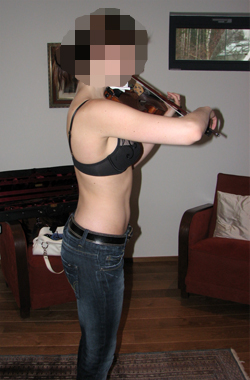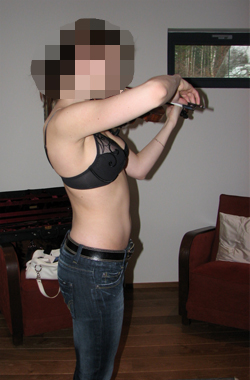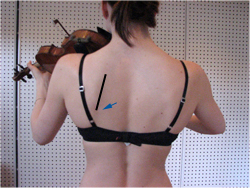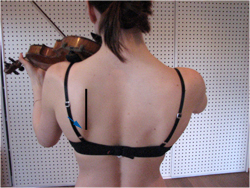Violin - harjoittelu
Violin
Read the Ergonomics Overview first.
The violinist's pelvis and spine should be in the centre position, while allowing for free movement during playing. Movements start from and end in the centre position. In other words, the centre position is the musician's basic position to which he or she always returns. In the centre position, the spine maintains its natural curves. The spinal curves vary between individuals; in the centre position, the backs and hips of different people may look different. The thoracic spine should be centred both vertically and laterally; violinists should avoid twisting to the right (a typical tendency). The support muscles ensure that the body remains straight.
|
|
|
The violinist's cervical spine rotates to the left and tilts slightly down. The chin and shoulder supports enable the correct position of the cervical spine and the head. If the chin support is too low or fits poorly to the shape of the chin, it pushes the head and neck too far forward and down, and the head tilts excessively to the side. A good chin rest ensures that the cervical spine and the head can move freely during playing. If the only way for the musician to hold the violin up is to squeeze it against the chin, another reason could be a faulty position of the shoulder blade. In this case, the shoulder blade support muscles cannot hold the shoulder blade in the vertical position and it tilts forward, causing the collarbone and the acromion (on top of the shoulder joint) to also tilt forward, and the violin slides down.
It is more difficult to keep the pelvis in the centre position when playing in a seated position. In the sitting position, the body's centre of mass moves forward, and the back extensors have to work harder to maintain the posture. When the pelvis tilts back and the lumbar spine straightens, the violinist is often forced to compensate for his or her posture by overextending the thoracic spine. This affects the control of the shoulder blade support muscles and increases the strain on the arms and the neck and shoulder area. When the centre position is maintained throughout the pelvis, the lumbar spine and the thoracic spine, the large muscles and the shoulder blade muscles function better, and the hands and fingers also move more freely.
The left hand shoulder joint should rotate sufficiently outwards. This ensures that the shoulder blade is in the correct position, even when going up to the G string. If the shoulder joint does not rotate outwards, the shoulder blade comes away from the ribs and rotates insufficiently, which affects the muscular support for the shoulder blade. The outward rotation of the bottom corner of the shoulder blade is essential for the natural movement of the shoulder joint and the normal function in the thoracic outlet area, superior aperture (the thoracic outlet, superior aperture, consists of the area between the shoulder blade, the collarbone and the spine).
|
|
|
In order to master different string techniques, it is important that the support muscles of the right shoulder blade function correctly. When raising the hand, the medial inferior angle (bottom corner) of the shoulder blade rotates outwards. As a result, the muscles of the shoulder blade and the shoulder joint function normally, and arm movement is easy and relaxed. If the shoulder blade wings off and/or its upper part tilts forward, the rotating movement is not possible, the shoulder joint and the superior aperture close up, and the muscles in the upper arm and the neck and shoulder area are overloaded. This incorrect action may cause problems in the bow hand, such as shaking, numbing, weakness and poor control.
When the palmar muscles function correctly, they retain the hand arches during playing (read more in the Ergonomics Overview). The grip of the bow is light; strings are played by squeezing them lightly. If the muscles that retain the palm arches function incorrectly, the arches fall and the knuckles (esp. those of fingers 4 and 5) drop, the palm closes and the forearm muscles (finger muscles that extend over the wrist) work too hard and become overstrained.
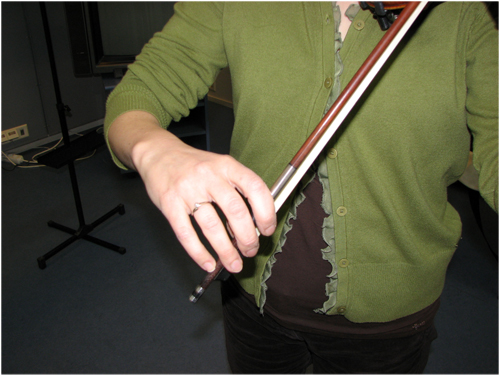
A natural arch across the knuckles enables a light and sensitive grip.
Same principles apply to a standing position and sitting position. In a seated position, the strain on the mid-back extensors is slightly higher, as the centre of mass is further out.

